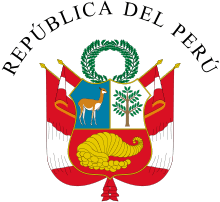Constitutional Court of Peru
The Peruvian Constitutional Court or Constitutional Tribunal[1] is an independent constitutional agency of Peru. Its historical headquarters are located in the city of Arequipa but it's national operative headquarters are located in the capital city of Lima. The Constitutional Court is the highest organ of constitutional control and interpretation in the country. It is an autonomous and independent organ that is only bound by the Peruvian Constitution and its Organic Law - Law N° 28301.
| Tribunal Constitucional Constitutional Court | |
|---|---|
 | |
| Established | 1980 (Court of Constitutional Guarantees) 1996 (Constitutional Court) |
| Location | Arequipa, Peru |
| Composition method | Congress of the Republic of Peru |
| Authorized by | Constitution of Peru |
| Judge term length | 5 Years |
| Number of positions | 7 |
| Website | http://www.tc.gob.pe/ |
| President of the Constitutional Court | |
| Currently | Manuel Miranda Canales |
| Since | 2016 |
Functions
The Constitutional Court is entrusted with upholding the principle of constitutional supremacy, against the laws or acts of state bodies that seek to undermine it and intervenes to restore respect for the Constitution in general and constitutional rights in particular. The Court is the one specialized organ that is responsible for this type of enforcement. It has the authority to review the adequacy of laws, draft laws and decrees of the executive, conducting a review of the constitutionality of such acts.
According to Kelsen's model, the Constitutional Court acts as a negative legislator, lacking the power to make laws but with the power to repeal all or portions of the unconstitutional laws/acts. More recent theories argue that the task of the Constitutional Court strictly involves judicial functions and resolving constitutional disputes, which may include a review of the performance of the legislature, the protection of fundamental rights and the distribution of powers between the branches of government.
Members
- President: Ernesto Blume Fortini
- Vice President: Manuel Miranda Canales
- Magistrate: Augusto Ferrero Costa
- Magistrate: Marianella Ledesma Narváez
- Magistrate: Carlos Ramos Núñez
- Magistrate: José Luis Sardón de Taboada
- Magistrate: Eloy Espinosa-Saldaña Barrera
References
- Nollkaemper, Andre (2011). National Courts and the International Rule of Law. Oxford, England: Oxford University Press. p. 203. ISBN 978-0-19-923667-1.